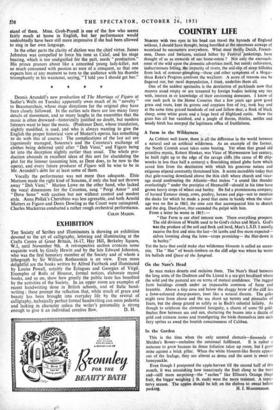A Farm in the Wilderness As Cobbett well knew, there
is all the difference in the world between a natural and an artificial wilderness. As an example of the former, the North Cornish coast takes some beating. Yet when that grand old primitive mystic, Robert Hawker, was Vicar of Moiwenstow last century, he built right up to the edge of the savage cliffs (the cause of 80 ship- wrecks in less than half a century) a flourishing Mixed glebe farm which saved him from the destitution with which his generous nature and exiguous stipend constantly threatened him. It seems incredible today that that gale-roaring downland above the thin cleft where church and vicar- age stand confronting the Atlantic—that makes " a sound like thunder everlastingly" under the precipice of Hennacliff—should in his time have grown heavy crops of wheat and barley. He fed a promiscuous company of horned Exmoor sheep, cows, poultry, horses and pigs—not to mention the ducks for which he made a pond that came in handy when the vicar- age was on fire in 1863, the nine cats that accompanied him to church and the dog, Dustyfoot, that ascended the pulpit with him.
From a letter he wrote in 1865:-
" Our Farm is our chief interest 'now. There everything prospers. The old division of Wealth used to be God's riches and Man's. God's was the produce of the soil and flock and herd, Man's L.S.O. I usually receive the first and niiss the last-34 lambs and five more expected— calves looming along the lawn—crops promising— the Hut-down is in barley."
Yet the hero that could make that wilderness blossom is called an eccen- tric. The " Hut " of wreck-timbers on the cliff edge was where he wrote his ballads and Quest of the Sangraal.


































 Previous page
Previous page